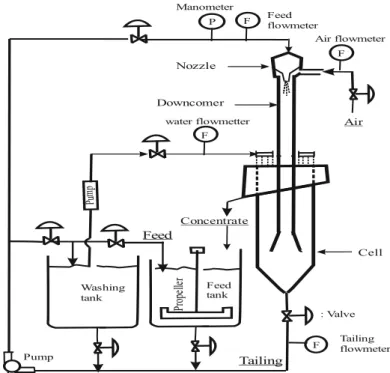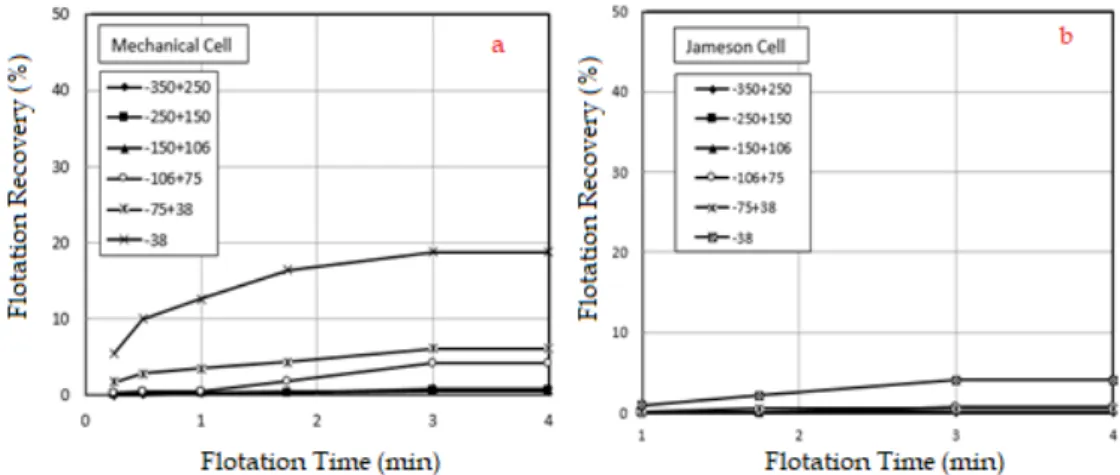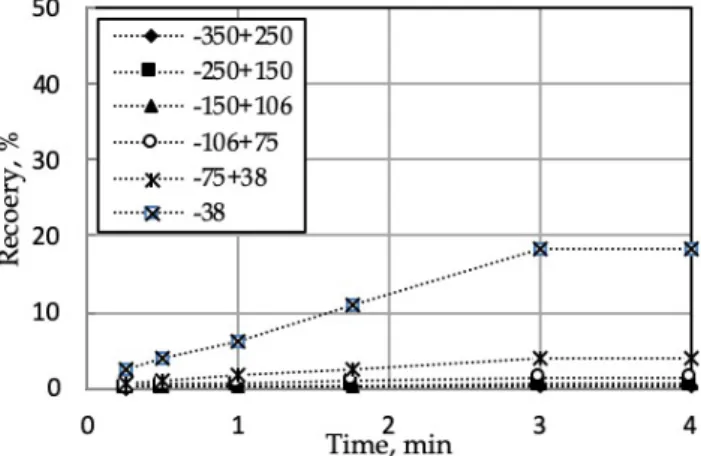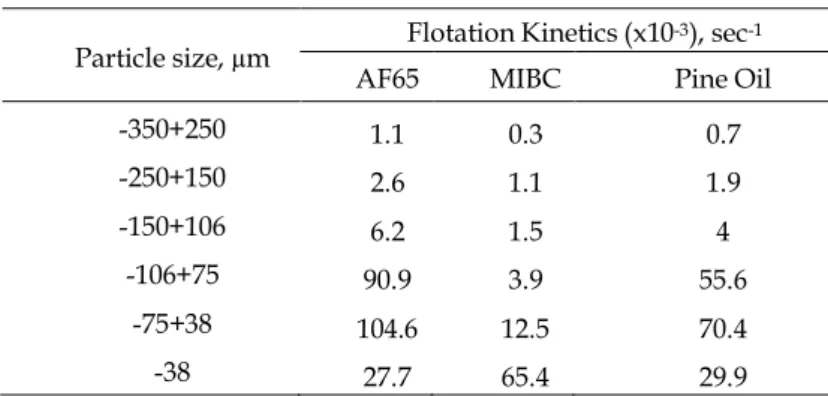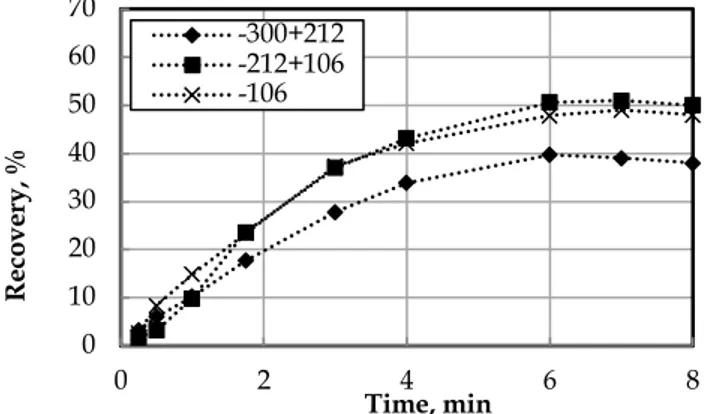DOI: 10.37190/ppmp/125917
http://www.journalssystem.com/ppmp
© Wroclaw University of Science and Technology Received July 21, 2020; reviewed; accepted August 01, 2020
Effects of frothers and particle size on the flotation kinetics of the
Jameson Cell
Oktay Şahbaz, Muhammet Kubilay Demir
Kutahya Dumlupinar University, Mining Engineering Department, Kutahya, 43100, Turkey Corresponding author: oktay.sahbaz@dpu.edu.tr (Oktay Şahbaz)
Abstract: Determination of the flotation kinetic is crucial for optimization, simulation, and plant design
for flotation processes. Even though there are many studies carried out to clarify the kinetic properties of the conventional flotation cells, there is not enough detailed study about the Jameson cell which is used more than 300 plants but no application in Turkey yet. One of the most important parameters affects the kinetic of flotation is a frother. The effects of common frothers on the kinetic of Jameson cell can be crucial due to the possible further application of the cell in European and Turkish flotation industries. The present study was performed out to reveal the kinetic properties of the Jameson cell by using both pure quartz and coal particles. Besides, the effects of three different types of frothers on the kinetic of the Jameson cell were investigated for various particles sizes. According to the results, aliphatic alcohol type frother (MIBC) provided higher recovery for fine particles, while polypropylene glycol type frother (AF65) gave a better ability to float medium and coarse size particles. Additionally, the results show that the Jameson cell was four times faster than the mechanical cell for medium size while the ratio was three times for coarse particles. Lastly AF65 can be used for flotation of coarse particles in the Jameson cell while MIBC can be preferred for fines.
Keywords: flotation kinetics, Jameson cell, frothers, particle size 1. Introduction
Flotation is a physicochemical kinetic process that is used to separate hydrophobic particles from hydrophilic particles (Drzymala, 2007). Determination of the kinetics is very crucial for scale-up, simulation, calculation of the recovery, and plant design of the flotation process. Therefore; researchers have carried out many studies to determine flotation kinetics of various conventional devices such as a mechanical cell, flotation column, etc. (Arbiter and Harris, 1962; Apling and Ersayın, 1986; Ahmed and Jameson, 1989; Gülsoy and Ersayın, 1996; Polat and Chander, 2000; Kowalczuk and Zawala, 2016). Also researches for determining the kinetic behaviour of some newcomer devices such as the Jameson cell has still been under consideration. Even though there are many studies carried out to clarify the kinetic properties of the conventional flotation cells, there are not many detailed studies focused on the Jameson cell.
The kinetics of the flotation process depends on many parameters such as particle size, bubble size, reactive type and amount, hydrodynamics, and so on. One of the important parameters that affect the kinetics of flotation is frother (Laskowski, 1993; Drzymala and Kowalczuk, 2018). The effects of common frothers on the kinetic of the Jameson cell can be crucial due to the possible further application of the cell in the European and Turkish flotation industries.
The Jameson Cell is a flotation device have more than 300 application worldwide. The cell has been preferred in flotation plants due to unique behaviour on producing fine air bubbles (0.4-1.0 mm) and faster collecting ability for hydrophobic particles (Evans et al., 1995). The hydrodynamic behaviour and qualification of the Jameson cell have been studied by numerous authors (Jameson, 1988; Atkinson, 1994; Evans et al., 1995; Harbort et al., 2002; Şahbaz et al., 2012). There are also some studies about
particle size-recovery relation and maximum floatable particle size in the Jameson cell (Harbort et al., 1999; Çınar et al., 2007; Sahbaz et al., 2013). On the other hand, there are only a few studies carried out for the determination of flotation kinetics in Jameson cell for various materials such as fly ash and coal (Uçurum, 2009; Hapugoda et al., 2012). But there is not still any study about the kinetics of the Jameson cell in the presence of various frother for various particle sizes.
In this study, the kinetic properties of the Jameson flotation cell were investigated in detail for the first time in the presence of three different neutral type frothers in the case of fine, medium, and coarse size quartz and coal particles. The flotation experiments were carried out with pure materials and real ore to make a detailed analysis.
2. Materials and methods 2.1. Materials
A quartz sample used in the flotation experiments was obtained from Muğla-Milas Region in Turkey. The purity of the sample was 98%, and the results for the chemical analysis carried out by X-Ray Fluorescence (XRF) method is presented in Table 1. The grain size of the sample “as received” was finer than 0.5 mm.
Table 1. Chemical analysis of the quartz sample Element in Oxide Content (%)
Na2O 1.2
MgO 0.44
SiO2 98.0
Others 0.36
The sample was, first, ground and classified various size groups by using the ball mill and laboratory type screens, and d80 of the particles were nearly 300, 200, 125, 90, 55, and 30 µm. Each size groups were subjected to the flotation experiments separately.
In the flotation experiments, dodecylamine (DDA) was used as a collector which was received from Merck (Germany) at analytical grade. The collector dosage was 50 g/Mg that provided a 35-40° of contact angle. According to Johansson and Pugh (1992) the less hydrophobicity would not influence froth stability. Thus, the effect of collector was limited in this study. A stock solution of 1 g/dm3 collector
was solved in the acidic solution, which was prepared with hydrochloric acid (pH 3), to use in the experiments because of the limited solubility of the collector in water. Besides, neutral type frothers, namely, aliphatic alcohol (MIBC-methyl isobutyl carbinol), neutral oil (pine oil), and polygylicol ether (Aero froth 65-AF65), were used in the experiments. The flotation chemicals used in this study were supplied by Cytec, USA.
Table 2. Flotation conditions
Parameters Value
Nozzle diameter, mm 3.8
Downcomer diameter, mm 20
Tailing flow, dm3/min 5.6
Feed flow rate, dm3/min
Airflow rate, dm3/min
6.0 5.8
To verify the flotation results of quartz sample, an additional series of experiments were conducted by the use of a coal sample, which was obtained from Zonguldak Region in Turkey. The hard-coal sample having 27.15% ash content with 4%moisture and 7809 kcal/kg was classified into three different size groups -300+212 (coarse), -212+106 (medium), and -106 (fine) µm. In the coal flotation experiments, neither the collector nor the other chemicals were used. In these experiments, MIBC, pine oil, and AF65 as the frothers were used in 10 g/Mg.
2.2. Methods
The quartz and coal samples of the selected size groups were dispersed in tap water by agitating in a feed tank of Jameson cell set up (Fig. 1) at 1100 rpm for 5 min. This was followed by the addition of
DDA for quartz. No collector was used for the coal flotation. The conditioned slurry then fed to the
downcomer via a slurry pump. The experimental conditions for the flotation experiments are given in Table 2.
In the flotation experiments, the laboratory-scale Jameson cell was used. The schematic view of the cell is shown in Fig. 1. The Jameson cell has two main part which is downcomer and separation tank (cell).
Fig. 1. The Jameson cell (Sahbaz et al., 2017)
For a typical experiment, the slurry is conditioned and pumped into the downcomer with high pressure (100-180 kPa). There is a nozzle at the top of the downcomer which creates high-pressure water plunging jet. This plunging jet action provides an air suction into the downcomer, and this air is broken up into fine bubbles (e.g., 0.4-1.0 mm). Particles are captured by these fine bubbles, and a three-phase mixture occurs in the downcomer.
The three-phase mixture passes from the base of the downcomer into the cell, which has a much greater cross-sectional area than the downcomer. As a result, the downward superficial velocity of the mixture is reduced, allowing the hydrophobic particle-laden bubbles to disengage from the liquid, rise to the surface and form a froth zone. Some hydrophilic particles, coming into the froth phase through entrainment, are washed down by the wash water into the liquid phase. Clean concentrate product reports to a launder while the liquid phase and hydrophilic particles leave through a valve at the base of the separation tank.
Samples obtained from the launder and bottom of the cell are dried and weighted to measure the recovery.
2.3. Determination of flotation kinetic
Calculation of flotation kinetics was performed using a method which was firstly used in the study of Arbiter and Harris (1962), and lately in the study of Uçar and Yargan (2009). According to the method, the flotation kinetics is given in Eq. 1.
!" !#
= -
%&'& (1) Air Feed Concentrate Tailing Tailing flowmeter : Valve F Feed flowmeter Nozzle Downcomer Cell Pump Pr op ell er Air flowmeter Manometer F water flowmetter Pu m p Feed tank P F Washing tank Fwhere C is the floatable particle amount (%) in the cell, t is the time (min), n is the degree of the equation which is one for the first-order kinetics equation.
The equation shows natural the logarithm of 1 minus fractional recovery for each size fraction as a function of time (min) by the integration of both sides of the equation. This represents the simplest form of the first-order kinetics with an analogy to chemical kinetics (Arbiter and Harris, 1962), which was judged to be adequate for comparing the performance of collecting data.
The recovery was calculated for the coal flotation by the use of Eq. 2:
( = '. (100 − /) 1. (100 − 2)⁄ . 100 (2) where C; the amount of floatable product (%), c; ash content of floating material (%), F; feed amount (%)
and f is ash content of the feed (%).
3. Results and discussion 3.1. Quartz flotation
In this study, firstly, collectorless flotation experiments were carried out to determine the mechanical carryover. According to the result, there was only between 2.5% and 4% of entrainment for the finest particle for each frother types, while there was nearly no mechanical carryover for the coarser particles (Fig. 2). According to the experiments carried out in the same conditions, the mechanical carryover was around 20% for the finest size group in the mechanical flotation cell having 1 dm3 capacity (Demir,
2016). Thus, the first experiments gave us to make a better analysis for further experiments. Besides, Fig. 2 shows the Jameson cell is an effective device that can be used for the cleaning stage of the flotation and/or may use in the flotation to provide higher grade in the product.
Fig. 2. Results for collectorless flotation of the quartz sample in the mechanical cell (a) (Demir, 2016) and Jameson cell (b)
The next series of experiments were carried out to determine the effect of different types of frothers on the quartz recovery using Jameson cell in the presence of 50 g/Mg DDA (Fig. 3, 4, and 5).
Fig. 3 shows the flotation recovery of quartz particles in the presence of 50 g/Mg DDA and 10 g/Mg AF65. According to the results, approximately 30% recovery was obtained for the particle size group of -106+75 and -75+38 µm. On the other hand, only 10% recovery was achieved by the use of coarse (-150+106 µm) and fine (-38 µm) particles. Besides, the flotation recovery for coarser particles was less than 5%. The coarser particle size groups of quartz were easily sunk to the bottom of the cell under the given flotation conditions.
The same trend was also observed for a flotation carried out by using the pine oil (Fig. 4). There was the only difference in the value of recovery which was 30%, 25%, 15%, and 3% for the particles having the size groups of -75+38, -106+75, -38, and -150+106 µm, respectively. Again, the recovery was less than 5% for the particles having the size of coarser than 150 µm.
Fig. 5 shows the quartz flotation results in the presence of MIBC frother, aliphatic alcohol. As seen from the Fig. 5 that the flotation recovery was 20% for the fine particles (-38 µm) while the recovery
degree was less than 5% for other size groups. There was a dramatic decrease in the recovery for all size groups except for the fine particles (-38 µm). It may come from the weak frothing ability of MIBC which is the frother producing small bubbles and dilute bubbly environment.
The flotation kinetics of the Jameson cell is fit to the first-order kinetic equation as seen in Fig. 6, 7, and 8. The kinetic of coarser size groups were not calculated due to not enough levitation. Slopes of any line in these Fig.s give the flotation kinetics for the given particle size groups. Therefore, the more vertical slope is, the higher the flotation kinetics is.
According to Fig. 6, the flotation kinetics for medium sizes were higher than the coarse and fine sizes in the presence of AF65 as the frother. The results for medium sizes were nearly the same (Fig. 6). On the other hand, the coarse particles had less flotation kinetics than the finer particles (Fig. 6).
Fig. 3. Effect of AF65 (10 g/Mg) on the quartz flotation recovery in the Jameson cell (50 g/Mg DDA)
Fig. 4. Effect of pine oil (10 g/Mg) on the quartz flotation recovery in Jameson cell (50 g/Mg DDA)
Fig. 7 shows the results of flotation kinetics in the presence of pine oil as the frother. The highest flotation kinetics were obtained for the particles having the size of -75+38 µm. The second higher flotation kinetics was obtained for the size of -106+75 µm. According to Fig. 7, the lowest kinetics was obtained for the coarsest quartz particles.
The results of the kinetics of particles in the presence of MIBC showed a different trend when compared with AF65 and pine oil (Fig. 8). The fastest flotation rate means the highest flotation kinetics was obtained for the finest particle (Fig. 8). It indicated that MIBC in the given condition did not produce sufficient bubbly mixture in the system. Therefore, flotation recovery and flotation kinetics for medium and coarse particles were low (Fig. 5 and 8). On the other hand, there was comparatively high recovery and flotation kinetics for the fine particles. It can attribute the production of fine bubbles in the presence of MIBC.
Finally, the flotation kinetics of quartz particles having various size groups were obtained as presented in Table 3. According to Table 3, the highest flotation kinetics was obtained for the particle
Fig. 6. Flotation kinetics for quartz sample by using the AF65
Fig. 7. Flotation kinetics for the quartz sample by using the pine oil
Fig. 8. Flotation kinetics for the quartz sample by using the MIBC -0.400 -0.350 -0.300 -0.250 -0.200 -0.150 -0.100 -0.050 0.000 0 1 2 3 4 Ln (1 -R) Time, min -150+106 -106+75 -75+38 -38 -0.400 -0.350 -0.300 -0.250 -0.200 -0.150 -0.100 -0.050 0.000 0 1 2 3 4 Ln (1 -R) Time, min -150+106 -106+75 -75+38 -38 -0.400 -0.350 -0.300 -0.250 -0.200 -0.150 -0.100 -0.050 0.000 0 1 2 3 4 Ln (1 -R) Time, min -150+106 -106+75 -75+38 -38
size of -75+38 µm in Jameson cell experiments with the presence of AF65. Also, the second-highest kinetics was obtained for -106+75 µm and AF65. The kinetics of experiments with MIBC and pine oil were low.
Table 3. Flotation kinetics comparison of frothers in Jameson cell Particle size, µm Flotation Kinetics (x10
-3), sec-1
AF65 MIBC Pine Oil
-350+250 1.1 0.3 0.7 -250+150 2.6 1.1 1.9 -150+106 6.2 1.5 4 -106+75 90.9 3.9 55.6 -75+38 104.6 12.5 70.4 -38 27.7 65.4 29.9
Additional series of experiments were carried out by the use of the hard-coal sample to understand the operational behaviour of the frother in the real flotation system.
3.2. Coal flotation
The classified coal samples were subjected to the lab-scale Jameson cell without any collector addition in the presence of selected frothers. To clarify the effect of frothers on particle size, the flotation experiments with fine (-106 µm), medium (-212+106 µm) and coarse (-300+212 µm) particle size groups were carried out. First, the experiments were carried out by the use of AF65 type frother. The results of the experiments are shown in Fig. 9.
Fig. 9 indicates that the highest recovery was obtained for the medium-sized particles. The recovery was lowest for the coarse particles while the fine particles had a better floating ability than the coarse one. The flotation recovery decreases for the coarse and fine particles can be attributed to high turbulence of bubbles and low probability of collision between bubble and particle (Kowalczuk et al., 2011). A turbulence occurring at the end of the downcomer breaks the bubble-particle aggregates and causes the particle detachment (Sahbaz et al., 2017). This affects coarse particles more than other size groups, and causes the recovery decrease. On the other hand, AF65 produces nearly 0.9 mm bubble size in the Jameson cell for the given conditions. This is a relatively big size for the bubble in the Jameson cell and decreases the collision probability for fine particles.
Fig. 10 includes the results coal flotation in the presence of pine oil as the frother. According to the results, the fine and medium size particles showed a similar trend in terms of recovery. On the other hand, the results are very low for coarse particles. Pine oil produced weak and very dilute froth, and therefore the turbulence in the systems become more effective. Therefore, more loss occurs in the pine oil flotation for the coarse particles when we compare it with AF65 results (Fig. 9 and 10).
Fig. 9. Effect of AF56 (10 g/Mg) on coal flotation recovery in Jameson cell
0 10 20 30 40 50 60 70 0 2 4 6 8 Re co ve ry (% ) Time (min) -300+212 -212+106 -106
According to the results obtained in the coal flotation by the use of MIBC, the highest recovery was obtained for the fine particles (Fig. 11). MIBC produced very fine bubbles app. 650 µm in size (Corona Arroyo et al., 2016). This creates a better environment for fine particles with the increase of collision with the fine bubbles. Therefore, as obtained in fine quartz flotation in this study, the high recovery was again obtained for fine coal flotation. Lower recovery for coarse particles may attribute to the weak frothing behaviour of MIBC. Therefore, coarse particles-bubble aggregates were easily broken and detachment occurred.
According to kinetic constant calculation of the coal flotation in the Jameson cell, as shown in Table 4, AF65 gave the highest flotation kinetics. The lowest kinetic constant was obtained by pine oil (Table 4). The highest kinetic constant was obtained by using the AF65 for medium particle size (Table 4).
Fig. 10. Effect of pine oil (10 g/Mg) on coal flotation recovery in Jameson cell
Fig. 11. Effect of MIBC (10 g/Mg) on coal flotation recovery in Jameson cell Table 4. Flotation kinetics comparison of frothers in Jameson cell and mechanical cell
Test Conditions Particle size (µm) Flotation Kinetics (x10-3), sec-1
Mechanical Cell (AF65) (Demir, 2016)
-300+212 44.6
-212+106 40.9
-106 90.2
Jameson Cell (AF65)
-300+212 121.7
-212+106 166.7
-106 136.7
Jameson Cell (MIBC)
-300+212 81.2
-212+106 112
-106 145.8
Jameson Cell (Pine Oil) -300+212 54.1 -212+106 72.9 -106 53.9 0 10 20 30 40 50 60 70 0 2 4 6 8 Re co ve ry , % Time, min -300+212 -212+106 -106 0 10 20 30 40 50 60 70 0 2 4 6 8 Re co ve ry , % Time, min -300+212 -212+106 -106
The results of the kinetics of coal flotation in the Jameson cell was also compared with Denver type mechanical flotation results for AF65 (Table 4). According to the results, the Jameson cell was nearly four times faster than the mechanical cell for the medium size, while this ratio was three times for coarse size and 1.5 times for fine particles (Table 4). The results of the study also show Jameson cell was faster flotation device in coarse particle flotation. It may be attributed to the findings of Tao (2004) that was fine bubbles improve the coarse particle flotation.
4. Conclusions
The present study was aimed to reveal the kinetic properties of the Jameson flotation cell which has limited application in Europe and no application in Turkey even it has more than 300 applications world-wide. In the flotation experiments, pure quartz and hard-coal samples were used in various size groups from the fine to the coarse. The effect of frothers such as AF65, MIBC, and pine oil on the kinetic of both quartz and coal flotation was also studied in detail. According to the results;
• Mechanical carryover in Jameson cell flotation was less than the mechanical flotation cell. This can provide a better flotation environment for the cleaning stage of the flotation.
• The highest recovery and the flotation kinetics were obtained for the medium particles in the presence of AF65. The smallest one was obtained for the coarse particles in the presence of pine oil. • The same trend for flotation kinetics was obtained for AF65 and pine oil, while it was different for
MIBC which provided higher recovery and faster flotation for the fine particles. It may be the reason for producing finer and dilute bubbles.
• The coarser the particle size was, the less recovery was for the Jameson cell flotation.
• Based on the results obtained from this study, it can be concluded that AF65 can be used for coarse particle flotation in the Jameson cell while MIBC can be preferred for fine particle flotation. Pine oil needs to be used in a high amount that may be costly for pilot-scale applications.
References
AHMED, N., JAMESON, G.J., 1989. Flotation kinetics. Mineral Processing and Extractive Metallurgy Review: An International Journal, 5, Issue (1-4), 77-99.
APLING, A.C., ERSAYIN, S., 1986. Reproducibility of Semi-Batch Flotation Test Work with The Leeds Open-Top Cell and of Derived Kinetic Parameter., Trans. I.M.M., Sec.C, 95, C83-88.
ARBITER, N., HARRIS, C.C., 1962. Flotastion Kinetics, in Froth Flotation. 50 Anniversary Volume, A.I.M.E. (Ed. D.W. Fuerstaneu), 215-246.
ATKINSON, B.W., 1994. Hydrodynamic characteristics of a plunging jet reactor. Ph. D. Dissertation, University of Newcastle, Australia.
CORONA-ARROYO, M.A., LÓPEZ-VALDİVİESO, A., LASKOWSKİ, J.S., ENCİNAS-OROPESA, A.,2015, Effect of frothers and dodecylamine on bubble size and gas holdup in a downflow column. Miner. Eng. 2015, 81, 109–115. ÇINAR, M., ŞAHBAZ, O., ÇINAR, F., KELEBEK, Ş., ÖTEYAKA, B., 2007. Effect of Jameson cell operating variables and
design characteristics on quartz-dodecylamine flotation system. Elsevier- Minerals Engineering, 20, 1391-1396. DEMIR, M.K., 2016. Comparison of the kinetic characteristics of the mechanical cell and Jameson cell. MSc Thesis,
Dumlupinar University, Kutahya, Turkey.
DRZYMALA, J., KOWALCZUK, P.B., 2018. Classification of Flotation Frothers. Minerals 2018, 8, 53.
EVANS, G.M., ATKINSON, B. and Jameson, G.J., 1995. The Jameson Cell. Flotation Science and Engineering, Ed. Matis K.A., Marcel Dekker Ic.
GÜLSOY, Ö. Y., ERSAYIN, S., 1996. A New Approach to Kinetic Characterization of Semi Batch Flotation Tests. Changing Scopes In Min. Proc, 6th Min. Proc. Symp., 629-634.
KOWALCZUK, PB., SAHBAZ, O., DRZYMALA, J., 2011. Maximum size of floating particles in different flotation cells. Minerals Engineering 24 (8), 766-771.
KOWALCZUK, PB. and ZAWALA, J., 2016. A relationship between time of three-phase contact formation and flotation kinetics of naturally hydrophobic solids. Colloids and Surfaces A Physicochemical and Engineering Aspects 506, 371-377.
HAPUGODA, P., O’BRIEN, G., MILLAR, J., OFORI, P., FIRTH, B., 2010. Determınatıon of flotatıon kınetıcs of coal graın types ın a pılot scale jameson cell usıng coal graın analysıs method. XXV Internatıonal mıneral processıng congress (ımpc) 2010 proceedıngs / Brısbane, Qld, Australıa.
HARBORT, G., LAUDER, D., MIRANDA, J., MURPHY, A., 1999. Size by size analysis of operating characteristics of Jameson cell cleaners at the Bajo de Alumbrera Copper/Gold Concentrator. Mill operators conference-Innovation in operating practice for the 21st century.
HARBORT, G.J., MANLAPIG, E.V. VEDEBONO, S.K., 2002. Particle collection within the Jameson cell downcomer., Trans. IMM Section C, V. 111/Proc. Australas IMM, 307.
HOŞTEN, Ç., TEZCAN, A., 1990. The Influence of Frother Type on the Flotation Kinetics of a Massive Copper Sulphide Ore. Minerals Engineering, 3, Issue (6), 637-640.
JAMESON, G.J., 1988. A new concept in flotation column design. Prec. Column Flotation '88, Ed., KVSSastry, Phoenix, Arizona.
JOHANSSON, G., PUGH, R.J., 1992. The influence of particle size and hydro- phobicity on the stability of mineralized froths. Inter. J. Miner. Process., 34, 1–21.
LASKOWSKI, J., 1993. Frothers and flotation froth, Mineral Processing and Extractive Metallurgy Review. 12, 61-89. POLAT, M. and CHANDER, S., 2000. First-order flotation kinetics models and methods for estimation of the true
distribution of flotation rate constants. International Journal of Mineral Processing, 58, 145- 166.
ŞAHBAZ, O., UÇAR, A., OTEYAKA, B., 2013. Velocity gradient and maximum floatable particle size in the Jameson cell, Minerals Engineering. 79-85.
SAHBAZ, O., ERCETIN, U., OTEYAKA, B., 2012. Determination of turbulence and upper size limit in Jameson flotation cell by the use of Computational Fluid Dynamic modeling. Physicochemical Problems of Minerals Processing, 533-544.
SAHBAZ, O., UÇAR, A., ÖTEYAKA, B., 2017, Downcomer modification in Jameson cell and its effect on coarse particle flotation, Particulate Science and Technology, 37(4), 510-515.
TAO., D., 2004. Role of Bubble Size in Flotation of Coarse and Fine Particles—A Review. Separation Science and Technology, 39, 4, 741–760.
UÇAR, A. and YARGAN, M., 2009. Selective separation of boron values from the tailing of a colemanite processing plant. Separation and Purification Technology, 68, 1–8.
UÇURUM, M., 2009. Influences of Jameson flotation operation variables on the kinetics and recovery of unburned carbon. Powder Technology, 191, 3, 240-246.

